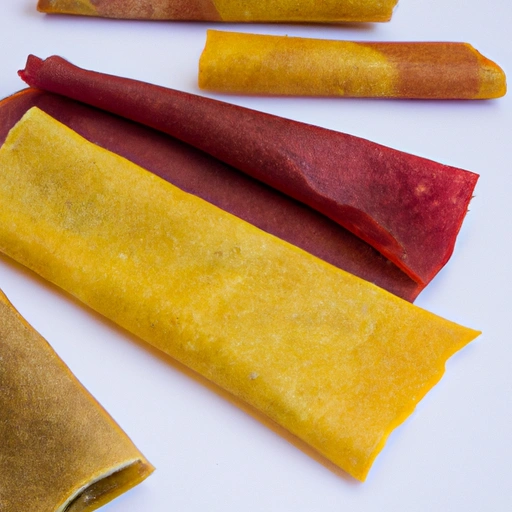Fruit Leather
Description

Fruit leather is a popular snack made by pureeing fruit and drying it into thin, chewy sheets. It combines the natural sweetness and nutrition of fruit with a convenient, non-perishable form. Fruit leather is appreciated for its long shelf life and compact size, making it a perfect snack for on-the-go. It is made without preservatives, though some commercial varieties may contain added sugars or colors.
Common uses
Fruit leather is commonly used as a snack or a sweet treat. It can be consumed on its own, torn into pieces, or cut into shapes for children. Additionally, it's sometimes used as a garnish on desserts, chopped into bits for cereal or yogurt toppings, or even as an unexpected ingredient in savory dishes for a hint of sweetness.
Nutritional value
Calories
A 1-ounce serving of fruit leather (approximately 28 grams) typically contains about 70-80 calories, depending on the type of fruit used and any added ingredients.
Protein
Fruit leather has a minimal protein content, often less than 1 gram per ounce.
Fat
Generally, fruit leather is fat-free unless it has been processed with added fats for texture or taste.
Carbohydrates
Carbohydrates are the primary macronutrient in fruit leather, with about 17-24 grams per ounce, mainly from natural fruit sugars and any added sweeteners.
Vitamins
Depending on the fruits used, fruit leather can be a source of vitamins such as vitamin C and various B vitamins.
Minerals
The mineral content of fruit leather can include potassium, magnesium, and trace amounts of calcium and iron, reflecting the nutritional profile of the original fruit.
Health benefits
Fruit leather is often rich in dietary fiber, particularly if the whole fruit is used, including the skin. The fiber can aid in digestion and promote satiety. The natural fructose found in fruit leather provides energy without causing rapid spikes in blood sugar levels when consumed in moderation. Furthermore, it can contribute to the daily intake of vitamins and minerals necessary for good health.
Potential risks
While fruit leather can be part of a healthy diet, it can also pose risks if consumed excessively. Some fruit leathers contain added sugars, which can increase calorie intake and contribute to dental decay. Additionally, commercially produced varieties may contain additives or preservatives that some individuals may wish to avoid. As with all sweet snacks, moderation is key.
Common recipes
Fruit leathers can be used as an ingredient in homemade granola bars, energy balls, and even in baking as a natural sweetener. They can be rehydrated and used in sauces or glazes for meats or desserts.
Cooking methods
The most common method of creating fruit leather is by pureeing fruit, spreading it thinly on a baking sheet or special dehydrator tray, and drying at a low temperature until it reaches the desired consistency.
Pairing with other ingredients
Fruit leather pairs well with nuts, seeds, and dairy products like cheese or yogurt, offering a balance of flavors and textures. It can also complement savory dishes with its sweet and tangy flavor profile.
Summary
Fruit leather is a versatile, nutritious, and durable food item that enjoys global popularity. It serves as a convenient way to enjoy the taste and nutritional benefits of fruit even when fresh produce is not available. Its application in various culinary practices is limited only by one's creativity, and it provides an exciting way to add natural fruit sweetness to a variety of dishes.